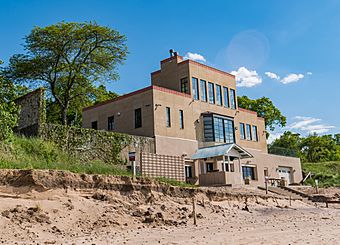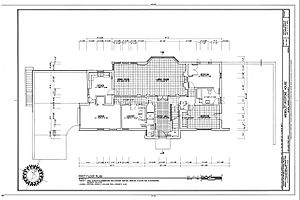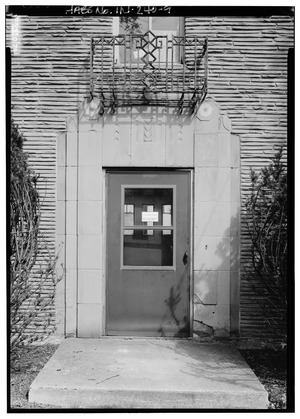Wieboldt-Rostone House facts for kids
Quick facts for kids |
|
|
Wieboldt-Rostone House
|
|
|
U.S. Historic district
Contributing property |
|

Beachfront facade
|
|
| Location | 208 Lake Front Dr., Beverly Shores, Indiana |
|---|---|
| Built | 1933 |
| Architect | Scholer, Walter; Et al. |
| Part of | Beverly Shores-Century of Progress Architectural District (ID86001472) |
| Added to NRHP | June 30, 1986 |
The Wieboldt-Rostone House is a special house built in 1933. It was made with a steel frame and covered in a new, artificial stone called Rostone. This material was supposed to last forever and never need fixing. However, it only lasted until the 1950s.
The house was built to show off Rostone, a new building material. Rostone was made from waste products like limestone dust and shale. The company, Rostone, Inc., worked with Indiana Bridge Company to create it. Building the house was simple because most parts were made in a factory. Panels were pre-made to the right sizes. Each panel had special nuts to bolt it onto the steel frame. Both the inside and outside walls were built this way. A designer named Walter Scholer created the house.
History of the Rostone House
The Wieboldt-Rostone House was first shown at the 1933 Century of Progress World's Fair in Chicago. It was part of a group of "Homes of Tomorrow." These homes were meant to show new ideas for building and living. The house was a big attraction at the fair.
The company Rostone Inc. and Indiana Bridge Co. rented a spot at the fair for $2100. They wanted to show how their new building material worked. The inside of the house was decorated by Tobey Furniture Co. This house was a peek into the future of homes!
What is Rostone?
Rostone is a man-made material. It is made from shale, alkaline earths (which are types of metals), and waste from limestone quarries. It could be made in many colors and shapes. Rostone was advertised as being as strong as natural limestone.
One big advantage was that it could be made in exact sizes. This made building easier and faster. However, Rostone did not last as long as people hoped. The outside of the Rostone House started to wear out after about ten years. In 1950, the house had to be covered with a different material called Permastone.
Moving to Beverly Shores
After the World's Fair ended, a man named Robert Bartlett bought several of the "Homes of Tomorrow." In 1935, he hired engineers to move them. The Wieboldt-Rostone House was moved to Beverly Shores, Indiana. It was placed right by the lake, with its big windows facing the water.
In 1934, sixteen buildings from the Century of Progress Exposition were moved. They traveled by barge (a flat boat) and truck to Beverly Shores. Robert Bartlett wanted to create a small exhibition of these modern homes. He hoped to attract people to buy land in his new neighborhood. The fair was very important during the Great Depression. Moving these houses helped people see a brighter future.
Restoring the House
Efforts to restore the Wieboldt-Rostone House began in 1997. The Indiana Dunes National Lakeshore and the Historic Landmarks Foundation of Indiana started looking for people to help. They wanted to find groups or individuals who would rent the house and fix it up. This way, the house could be saved and enjoyed for many more years.



